Welcome to South Carolina, home to many species of bluebirds. This region is known for its diverse bird population, including five species of bluebirds that can be found living here.
From the bright blue and orange of the Eastern Bluebird to the deep blue and white of the Indigo Bunting, these birds are a sight to behold. South Carolina offers an ideal habitat for these birds, with plenty of open fields, wetlands, and woodlands for them to call home.
In addition, the abundance of insects, fruits, and seeds makes this an ideal place for bluebirds to feed and breed. With a little bit of luck and some careful observation, you may even be able to spot some of these beautiful birds in your backyard.
1. Eastern Bluebird

The eastern bluebird is a small migratory bird native to North America. It can be found in open woodlands, farmlands, and orchards, making it a common sight in rural areas.
The male eastern bluebird is easily identified by its bright blue breeding plumage, which stands out against its more muted surroundings. This striking appearance is one of the reasons that the eastern bluebird is a favorite among birders.
The eastern bluebird can often be seen perched atop a wire or other open perch, making it easy to observe and appreciate its beauty. The eastern bluebird is an important part of the environment, and its presence is a sign of a healthy ecosystem.
| Kingdom | Animalia |
| Phylum | Chordata |
| Class | Aves |
| Order | Passeriformes |
| Family | Turdidae |
| Genus | Sialia |
| Species | S. Sialis |
2. Blue Jay
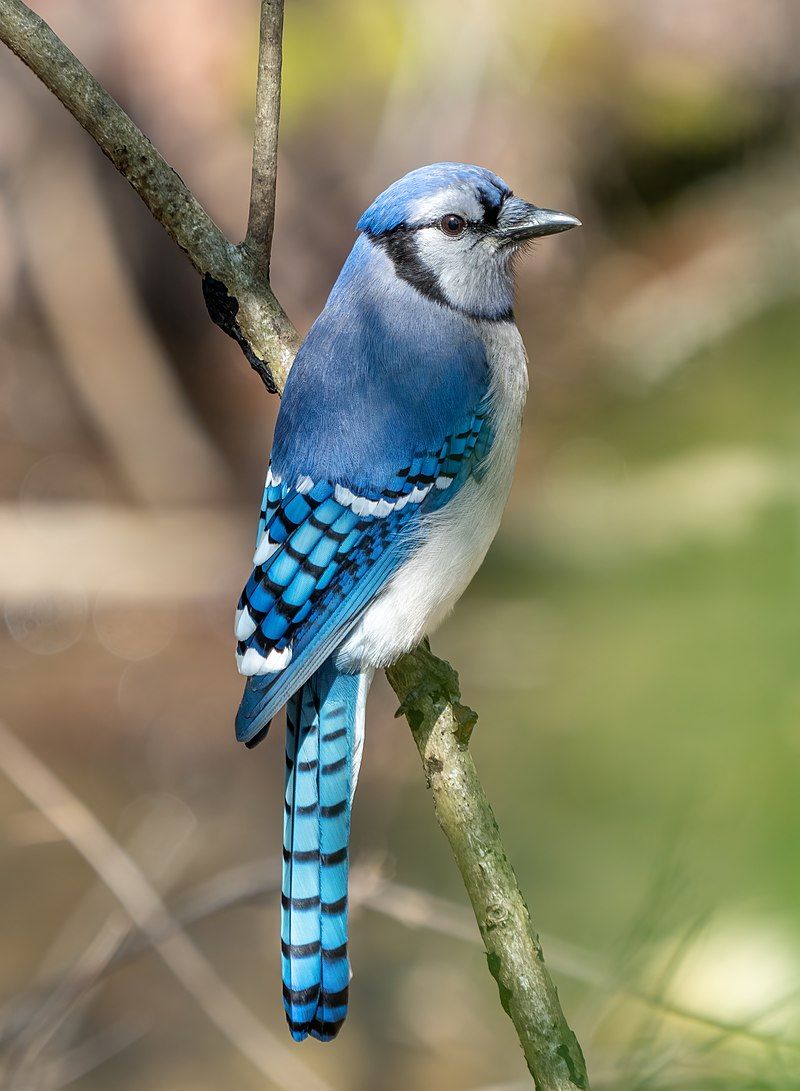
The blue jay is a bird that is part of the family Corvidae, which is found in the eastern parts of North America. Blue jays can be found living in the eastern and central United States, with certain populations being migratory.
In addition, blue jays have been found residing in Newfoundland, Canada, and have been known to breed in southern Canada. This species is quite widespread in the eastern parts of North America, with its habitats ranging from forests to gardens.
Blue jays are quite easily identifiable due to their stunning blue color and white markings on their wings and tail. They are also quite vocal, often making loud calls and noises. This can be heard during the mating season when they are trying to attract a mate.
Blue jays are also known to be quite intelligent, as they can remember where food sources are and will often cache food for later consumption. They also have a very varied diet, which includes insects, nuts, berries, and other small animals.
Overall, blue jay is a beautiful species that is found in the eastern parts of North America. They are easily identifiable due to their bright blue coloring and white markings and are quite vocal during the mating season.
They are also quite intelligent, with an impressive ability to remember where food sources are located and cache food for later use. With their varied diet, they can survive in a wide range of habitats.
| Kingdom | Animalia |
| Phylum | Chordata |
| Class | Aves |
| Order | Passeriformes |
| Family | Corvidae |
| Genus | Cyanocitta |
| Species | C. cristata |
3. Indigo Bunting
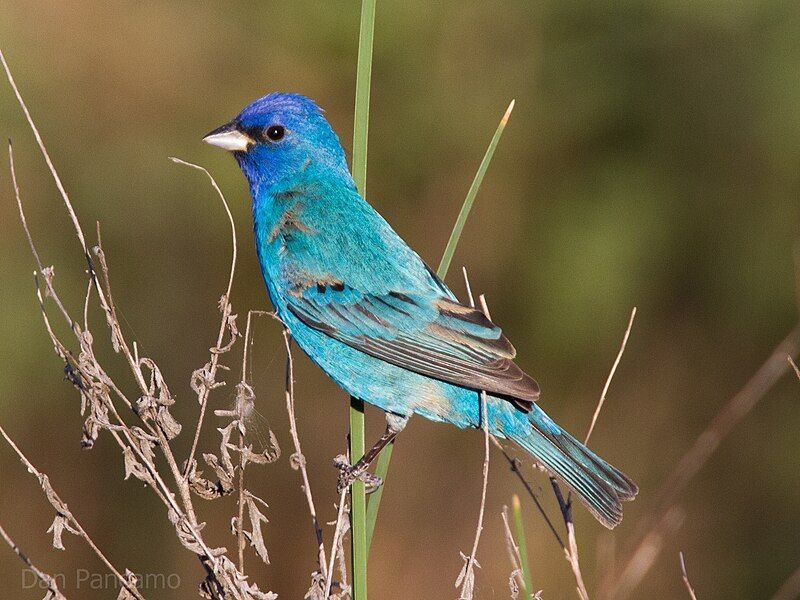
The indigo bunting is a small, seed-eating bird that belongs to the cardinal family. This bird is migratory, which means that it moves between different habitats depending on the season.
During the breeding season, it can be found in regions ranging from southern Canada to northern Florida. In the winter, it migrates southwards to southern Florida and even as far south as northern South America.
The indigo bunting migrates mainly at night, using the stars as a way to guide its journey. By flying at night, the indigo bunting avoids many predators that could endanger it during the day.
Additionally, the stars provide a helpful navigation tool, making it easier for the bird to find the way to its final destination in the dark. The indigo bunting’s yearly migrations are a long and arduous journey, but it is a critical part of the bird’s behavioral pattern.
Its ability to travel vast distances is a testament to its resilience and determination. The indigo bunting is an amazing example of the ingenuity and strength of animal species in the wild.
| Kingdom | Animalia |
| Phylum | Chordata |
| Class | Aves |
| Order | Passeriformes |
| Family | Cardinalidae |
| Genus | Passerina |
| Species | P. cyanea |
4. Tree Swallow

The tree swallow is a migratory bird belonging to the family Hirundinidae. This bird is found in the Americas and was first described in 1807 by the French ornithologist Louis Vieillot.
It was originally classified as Hirundo bicolor but has since been moved to its current genus, Tachycineta. Despite the move, its phylogenetic placement is still being debated. Tree swallows have a wide variety of habitats, from open fields to forests.
They can be seen flying above fields and meadows, as well as near water bodies where they forage for food. They feed mainly on flying insects and other arthropods. Tree swallows are also known for their habit of nesting in tree cavities.
They use mud and plant fibers to build their nests. Tree swallows have distinctive plumage, with a blue-green upper body and a white underside. Males are particularly striking with their bright blue throat and forehead.
Tree swallows are highly social birds and can often be seen in large flocks. They also perform acrobatic aerial displays during courtship. The tree swallow is an important part of the ecosystem in the Americas.
They help to control insect populations, while also providing an important food source for other animals. The tree swallow population is also important for scientific study, as it can provide insight into the evolutionary history of migratory birds.
| Kingdom | Animalia |
| Phylum | Chordata |
| Class | Aves |
| Order | Passeriformes |
| Family | Hirundinidae |
| Genus | Tachycineta |
| Species | T. bicolor |
5. Painted Bunting
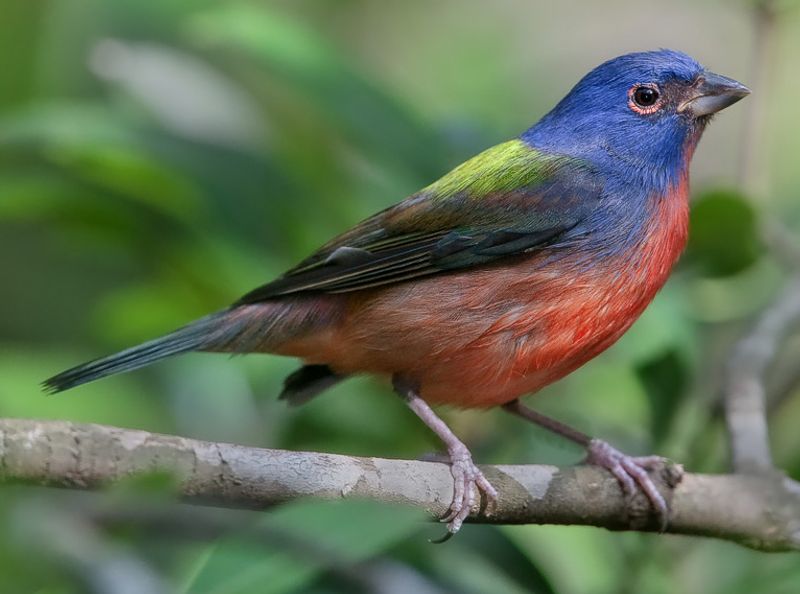
The painted bunting is a species of bird from the cardinal family, Cardinalidae. It is native to North America and is easily distinguishable due to its brightly colored plumage. The male of this species is particularly striking with its hues of blue, green, and red.
It is important to note, however, that the male does not display this bright plumage until the second year of his life. In the first year, distinguishing a male from a female requires close inspection.
This is because the first-year males have a less vibrant feather coloration that is similar to the females. This makes it difficult to spot a male until it has reached its second year of life.
| Kingdom | Animalia |
| Phylum | Chordata |
| Class | Aves |
| Order | Passeriformes |
| Family | Cardinalidae |
| Genus | Passerina |
| Species | P. Ciris |
6. White-Breasted Nuthatch

The white-breasted nuthatch is a species of bird that belongs to the nuthatch family known as Sittidae. It is a medium-sized bird that measures approximately 15.5 cm in length, making it larger than some other species of nuthatches.
This bird is mostly found in North America, although it has also been spotted in Eurasia. Its upperparts are grayish-blue in color, while its underside is white.
The white-breasted nuthatch has a slightly curved black bill and a white face with a black line extending from its bill to its eyes. It is known for its unique call, which consists of a loud “yank” followed by a softer “yank”.
This species of bird feeds mostly on insects, nuts, and seeds. It is often seen foraging on trees, using its long, sharp claws and bill to search for food. The white-breasted nuthatch is known to be a very social bird, often forming flocks with other species of birds.
It is also known to be a good nest-builder, constructing its nest in tree cavities or even abandoned woodpecker holes. Overall, the white-breasted nuthatch is an interesting species of bird that is worth taking the time to observe.
| Kingdom | Animalia |
| Phylum | Chordata |
| Class | Aves |
| Order | Passeriformes |
| Family | Sittidae |
| Genus | Sitta |
| Species | S. carolinensis |
7. Little Blue Heron
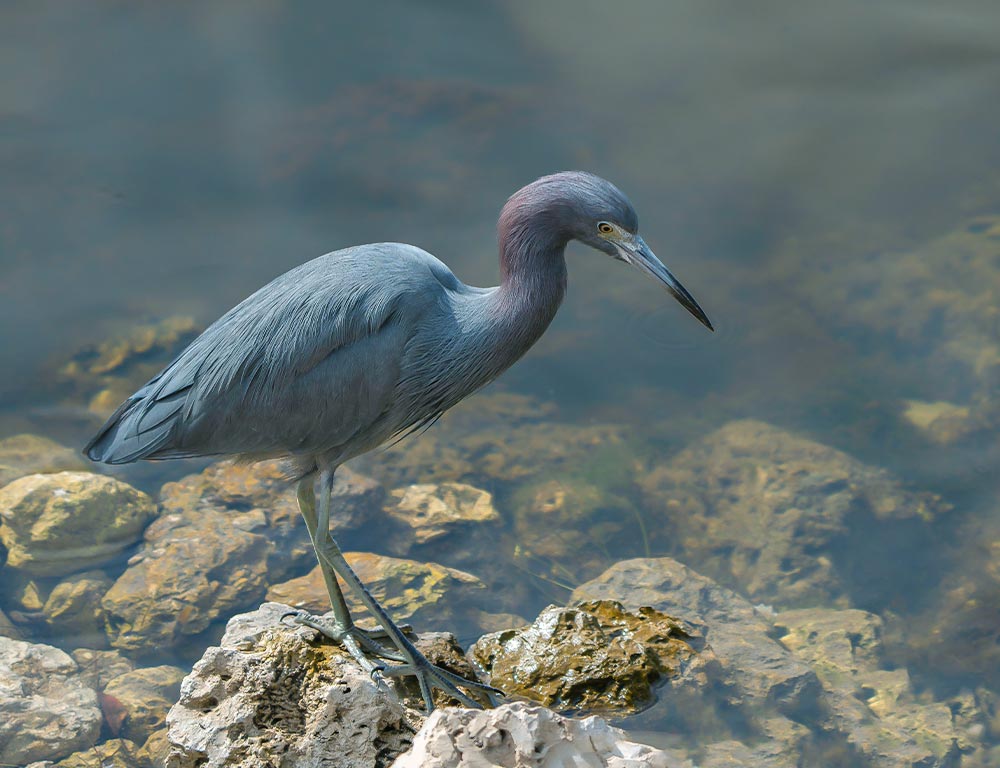
The little blue heron is a small species of heron belonging to the genus Egretta. It is a dark-colored bird with a two-toned bill, and juveniles of this species are completely white, making them resemble the snowy egret.
During the breeding season, adults of this species develop distinct coloration on their heads, legs, and feet. This coloration is usually gray to blue-green and helps to differentiate them from the juveniles.
The bill of the adult little blue heron also changes color during the breeding season, usually turning a deep yellow. This species of heron is a solitary bird, but during the breeding season, they will form small colonies near wetlands and freshwater habitats.
They feed mainly on small fish, frogs, insects, and crustaceans. The little blue heron is a unique and beautiful bird, and its striking coloration can be admired throughout its range.
| Kingdom | Animalia |
| Phylum | Chordata |
| Class | Aves |
| Order | Pelecaniformes |
| Family | Ardeidae |
| Genus | Egretta |
| Species | E. caerulea |
8. Belted Kingfisher
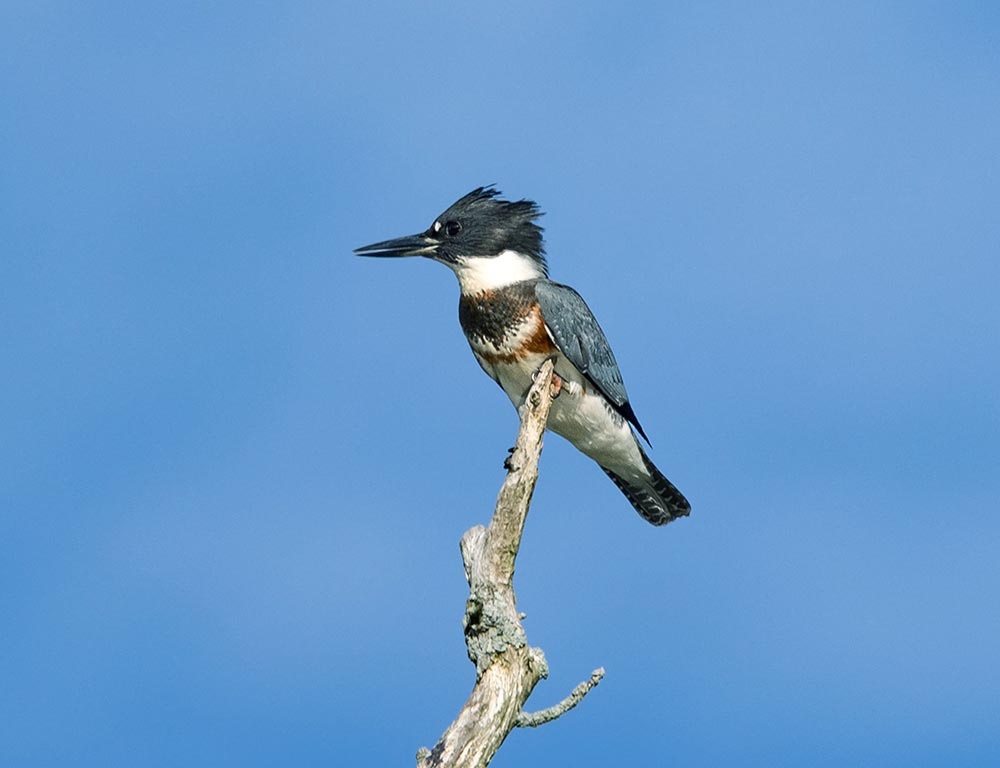
The belted kingfisher is a species of water kingfisher native to North America and is easily recognizable due to its large size and bright colors. Traditionally, all kingfishers were placed in a single family, Alcedinidae.
However, recent advances in research have suggested that the family should be divided into three subfamilies. This means that the belted kingfisher, along with other species of kingfishers, would be placed in one of these three subfamilies, rather than in the larger family.
By creating these three subfamilies, it allows for a more detailed analysis of the different species of kingfishers, and a better understanding of the similarities and differences between them.
Researchers have been able to use this information to gain insights into the ecology and behavior of different species. Additionally, it has provided a better understanding of how kingfishers evolved and how they are related to one another.
| Kingdom | Animalia |
| Phylum | Chordata |
| Class | Aves |
| Order | Coraciiformes |
| Family | Alcedinidae |
| Genus | Megaceryle |
| Species | M. alcyon |
9. Great Blue Heron

The great blue heron is a magnificent bird that can be found near the shores of open water and wetlands in many regions of the Americas.
It is part of the heron family Ardeidae and is native to North and Central America, northwestern South America, the Caribbean, and the Galápagos Islands. It is a large wading bird, reaching up to over four feet in height, with a wingspan of over six feet.
It has a long neck, a long pointed bill, and long legs. Its feathers are blue-gray and white, with a black-tipped beak. It is an excellent fisherman, standing still in shallow water where it waits for small fish and other aquatic prey.
It is also an iconic bird in many parts of the Americas, often seen perched atop a post or tree, surveying its surroundings.
| Kingdom | Animalia |
| Phylum | Chordata |
| Class | Aves |
| Order | Pelecaniformes |
| Family | Ardeidae |
| Genus | Ardea |
| Species | A. herodias |
10. Common Starling

The common starling is a type of bird that belongs to the starling family, Sturnidae. It is a medium-sized passerine bird, meaning it has a slender body and long wings.
It is commonly found in North America, where it is known as the European starling, and in Great Britain and Ireland, where it is simply called the starling.
This species of bird is usually found in open grasslands, gardens, fields, and agricultural areas, where it feeds on insects, small invertebrates, and seeds. It is known for its distinctive black-and-white speckled plumage and its loud chirping call.
It is also a social bird, often seen in large flocks. This species is a popular bird in both Europe and North America, where it is a common sight in both urban and rural areas.
| Kingdom | Animalia |
| Phylum | Chordata |
| Class | Aves |
| Order | Passeriformes |
| Family | Sturnidae |
| Genus | Sturnus |
| Species | S. vulgaris |
11. Red-Breasted Nuthatch
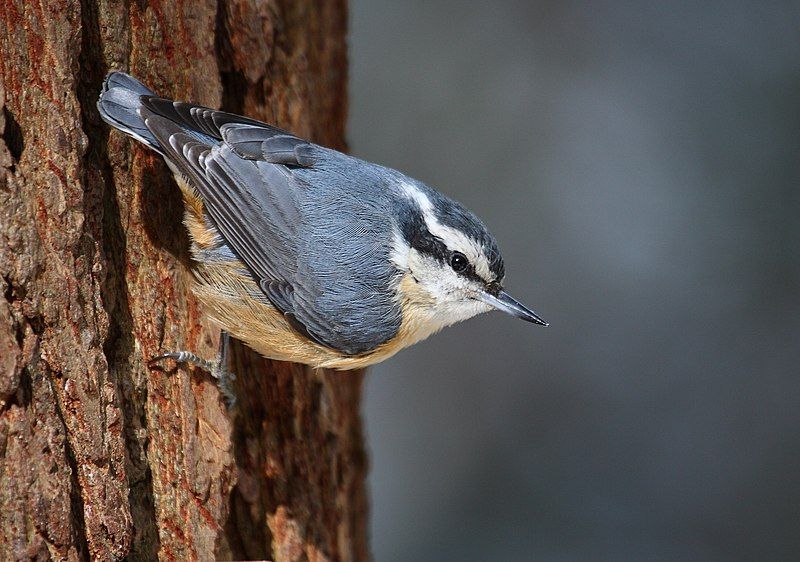
The red-breasted nuthatch is a small songbird that is easily recognizable for its distinct color pattern. The adult has a blue-grey color to its upperparts, with cinnamon-colored underparts. Its face and throat are white, and it has a black stripe that goes through its eyes.
It has a straight grey bill with a black crown. Its call has been likened to a tin trumpet, as it is high-pitched and nasal. The call of the red-breasted nuthatch is unique and can be heard from a distance.
It serves as a way for the bird to communicate with others of its species, as well as to mark its territory. The red-breasted nuthatch is a fascinating bird that has a beautiful call and a unique color pattern.
| Kingdom | Animalia |
| Phylum | Chordata |
| Class | Aves |
| Order | Passeriformes |
| Family | Sittidae |
| Genus | Sitta |
| Species | S. canadensis |
12. Cerulean Warbler
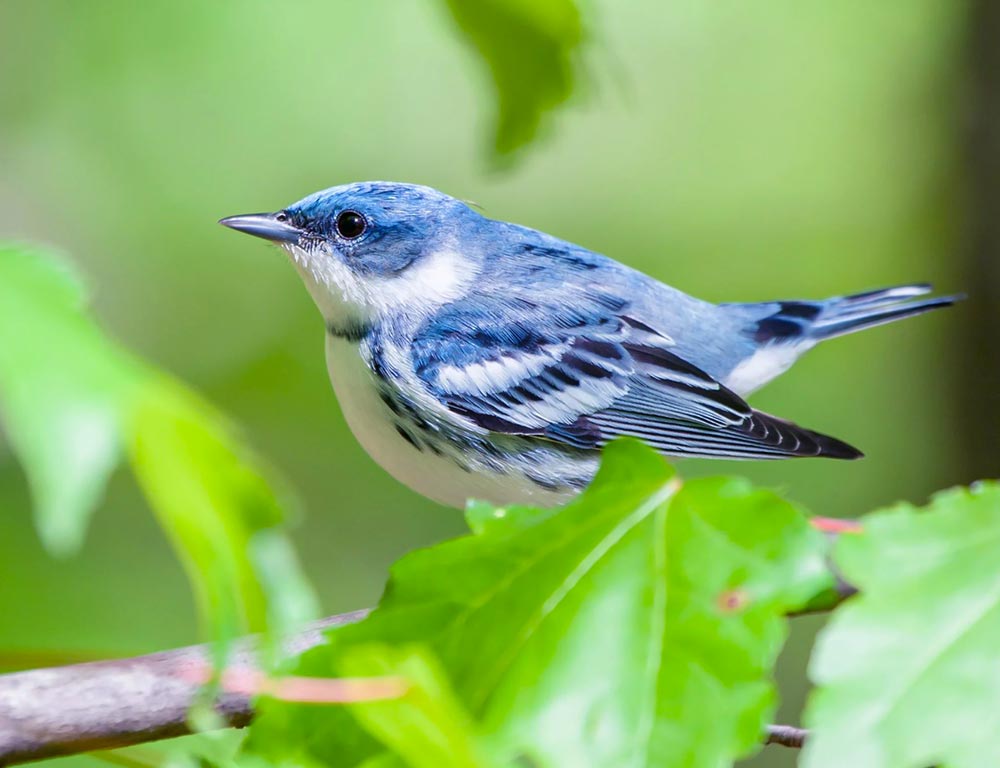
The cerulean warbler is a species of bird belonging to the family Parulidae. This small songbird is a long-distance migrant, meaning it migrates from one place to another at different times of the year.
During the breeding season, it is found in hardwood forests located in the eastern parts of North America. However, in the non-breeding season, it migrates to subtropical forests located on the eastern slope of the Andes mountain range in South America.
Therefore, this species is capable of traveling long distances to find suitable habitats for its wintering period. This unique trait is likely a result of its evolutionary adaptations, allowing it to survive in the changing climates of its range.
| Kingdom | Animalia |
| Phylum | Chordata |
| Class | Aves |
| Order | Passeriformes |
| Family | Parulidae |
| Genus | Setophaga |
| Species | S. cerulea |
13. Tufted Titmouse

The tufted titmouse is a small songbird native to North America and is a member of the tit and chickadee family. Tufted titmice are found in the eastern and central United States, as well as parts of Canada.
They are easily identified by their gray and white plumage and distinctive black crest. The black-crested titmouse was previously considered a subspecies of the tufted titmouse but is now classified as a separate species, Baeolophus atricristatus.
These titmice are found in the southern and central parts of Texas and have a slightly different appearance than the classic tufted titmouse.
They have a gray back and wings, and a white belly, with a large black crest and a black line running down the back of the neck. Overall, the tufted titmouse and the black-crested titmouse are both species of small birds that are found in North America.
While the tufted titmouse is found throughout most of the continent, the black-crested titmouse is only found in the south-central parts of Texas. Though they were previously grouped, the two species are now classified separately.
| Kingdom | Animalia |
| Phylum | Chordata |
| Class | Aves |
| Order | Passeriformes |
| Family | Paridae |
| Genus | Baeolophus |
| Species | B. bicolor |
14. Blue-throated Mountain gem
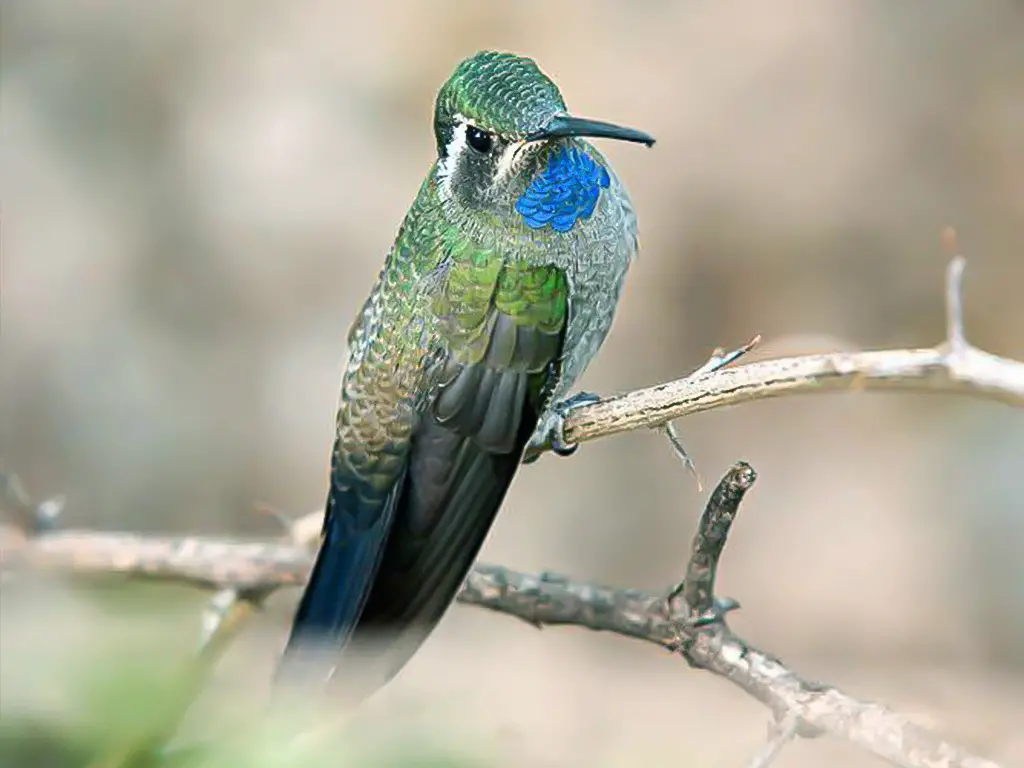
The blue-throated mountaingem (also known as the blue-throated mountain-gem or blue-throated hummingbird) is a species of hummingbird belonging to the tribe Lampornithini, which is part of the subfamily Trochilinae.
This species of hummingbird is native to the United States and Mexico. It has a unique blue throat, which is a distinctive feature of this species. The blue-throated mountain is a small bird, usually measuring between 4 and 5 inches in length.
It has a bright green back, a white underside, and a white throat. Its wings are dark brown, and its tail is pointed and black. The blue-throated mountain gem prefers a habitat of high-elevation forests, usually in the mountains.
It feeds on nectar from a variety of flowers, as well as small insects. It is an active species, and can often be seen hovering around flowers while foraging for food.
This species is usually seen alone or in pairs and does not form large flocks like other species of hummingbirds. The blue-throated mountain gem is an important species for the ecosystem in its native range, as it helps to pollinate flowers and disperse seeds.
It is also an important food source for other species such as hawks and bats. Unfortunately, due to habitat destruction and other human activities, the population of this species has been declining in recent years.
Conservation efforts are underway to help protect this species and its habitat.
| Kingdom | Animalia |
| Phylum | Chordata |
| Class | Aves |
| Clade | Strisores |
| Order | Apodiformes |
| Family | Trochilidae |
| Genus | Lampornis |
| Species | L. clemenciae |
15. Black-throated Blue Warbler

The black-throated blue warbler is a small bird that belongs to the New World warbler family. It lives in deciduous and mixed coniferous forests located in eastern North America, where it breeds.
During the colder months, it migrates to islands in Central America and the Caribbean. This is an adaptation to the colder temperatures and the lack of food sources in the northern hemisphere. The warbler is known for its bright blue feathers and its distinctive black throat.
It is a fairly common bird in its breeding range, but its numbers have declined in recent years due to habitat loss and degradation. Conservation efforts are underway to protect its habitat and ensure its survival.
| Kingdom | Animalia |
| Phylum | Chordata |
| Class | Aves |
| Order | Passeriformes |
| Family | Parulidae |
| Genus | Setophaga |
| Species | S. caerulescens |
16. Lazuli Bunting

The Lazuli Bunting is a type of songbird that is native to North America. It is a small bird with a vibrant blue-green coloration that is reminiscent of the gemstone lapis lazuli, from which it takes its name.
The species is migratory, breeding in the western and central parts of North America during the summer and spending the winter in warmer climates in the south, such as Mexico and Central America.
The Lazuli Bunting is a member of the Cardinalidae family and is closely related to other species such as the Blue Grosbeak and Indigo Bunting. Its diet consists of insects, seeds, and berries, and it typically nests in shrubs and trees near the ground.
The Lazuli Bunting is a popular bird for birdwatchers, and its stunning blue coloration has made it a favorite among bird enthusiasts.
| Kingdom | Animalia |
| Phylum | Chordata |
| Class | Aves |
| Order | Passeriformes |
| Family | Cardinalidae |
| Genus | Passerina |
| Species | P. amoena |
17. Blue Grosbeak
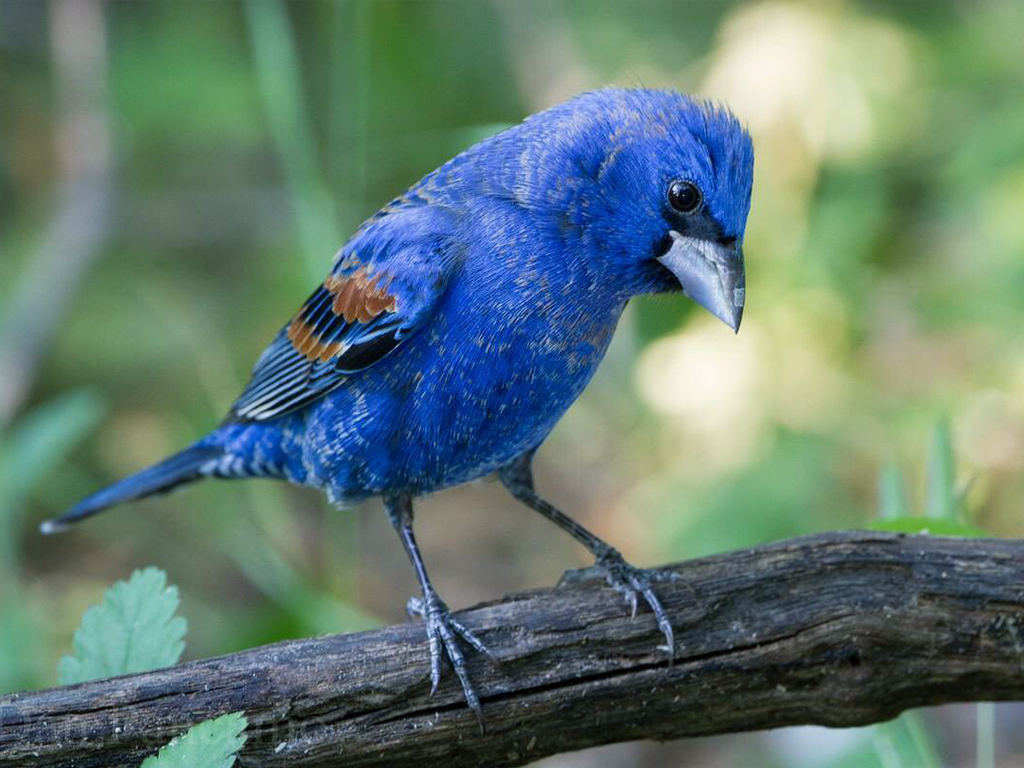
The blue grosbeak is a species of passerine bird native to North America. It belongs to the family Cardinalidae, which includes other birds such as cardinals, buntings, and grosbeaks. The blue grosbeak is a medium-sized bird with a length of approximately 7-9 inches.
The male of the species is distinguished by its bright blue plumage with two brown wing bars. Females are a duller brown or gray color, with a faint yellow wash on the underside. The blue grosbeak is mainly migratory, which means it travels from one area to another seasonally.
During the winter months, they can be found in Central America, while during the breeding season, they are found in northern Mexico and the southern United States.
At this time, males become more vocal and can be heard singing from the treetops. The blue grosbeak is an omnivorous bird, meaning it will eat both plants and animals. It mainly eats insects, but will also consume other small invertebrates, seeds, and fruits.
It is a common sight in backyards and fields, and can often be seen perched atop tall trees or foraging on the ground. The blue grosbeak is a beautiful and unique species that is an important part of North American wildlife.
It is an important pollinator, helping to spread the pollen of plants and flowers, and its presence is an indication of a healthy ecosystem. Its bright colors and melodic song make it an enjoyable species to observe and appreciate.
| Kingdom | Animalia |
| Phylum | Chordata |
| Class | Aves |
| Order | Passeriformes |
| Family | Cardinalidae |
| Genus | Passerina |
| Species | P. caerulea |
18. Northern Parula
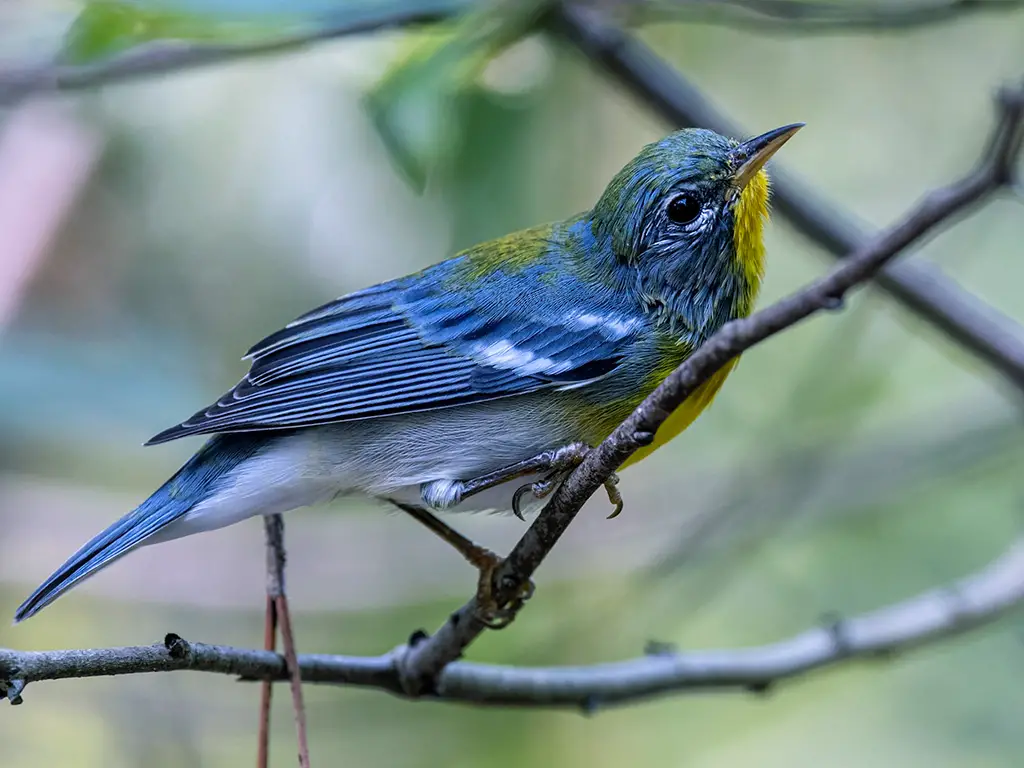
The northern parula is a type of small bird belonging to the New World Warbler family. It can be found in North America, where it breeds during the summer months. Its breeding grounds span from southern Canada down to Florida, making it a widely distributed species.
Its small size and active nature make it a unique and interesting creature. It is an attractive bird due to its bright yellow-green chest and blue head. It is often found in open woodlands, living and foraging among the branches.
Its diet consists mainly of insects, which it catches using its sharp beak and agile wings. The northern parula is a fascinating bird to observe in its natural environment, and it is a valuable part of the North American ecosystem.
| Kingdom | Animalia |
| Phylum | Chordata |
| Class | Aves |
| Order | Passeriformes |
| Family | Parulidae |
| Genus | Setophaga |
| Species | S. americana |
19. Blue-Headed Vireo
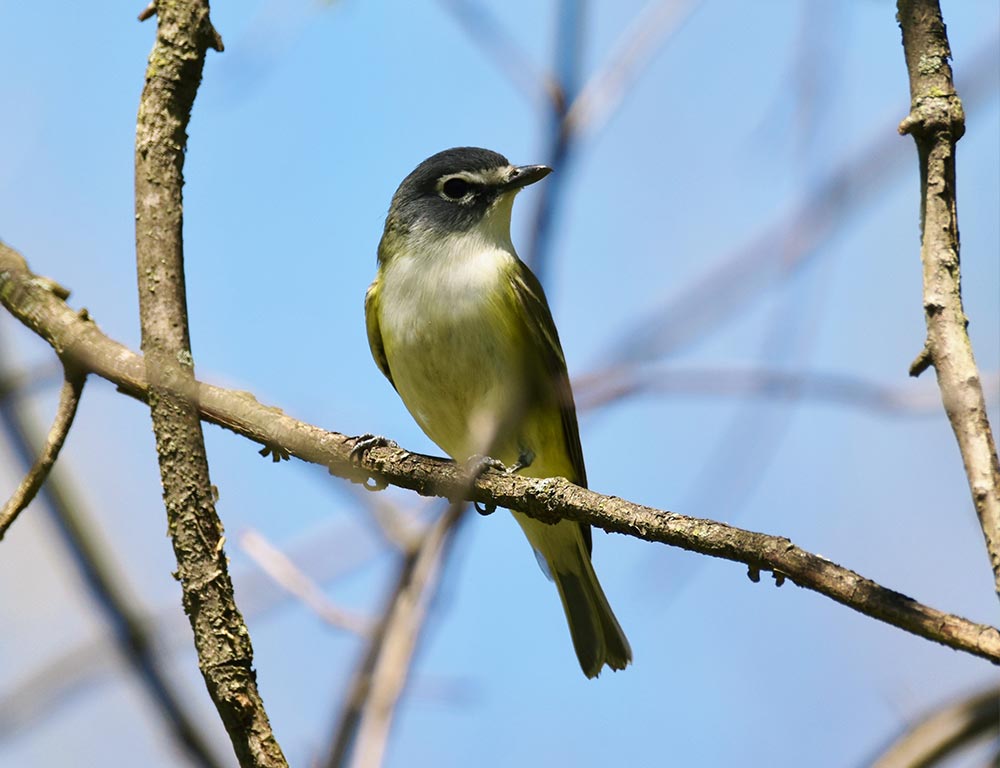
The blue-headed vireo is a type of migratory songbird that is found in North and Central America. It is a popular species, with two recognized subspecies that have a wide-ranging habitat.
The range of this species encompasses Canada and the eastern United States, Mexico, and parts of Central America. The blue-headed vireo is a colorful bird with a bright blue head, grey back, and white underside.
Its wings and tail are also grey, and the head is adorned with a white stripe running from the eyes to the base of the bill.
The blue-headed vireo is a small bird, measuring around five inches in length and having a wingspan of around seven inches. This species is mainly found in wooded areas and thickets, where it forages for insects and berries.
It is a migratory species, traveling south for the winter and returning north in the spring. During the breeding season, the blue-headed vireo will build its nest in the upper branches of trees, usually within a few meters of the ground.
This species will also form loose colonies with other vireo species, and can often be heard singing its beautiful song. The blue-headed vireo is considered to be of least concern by the IUCN, indicating it is not currently under threat of extinction.
However, several factors could potentially affect this species in the future, such as habitat destruction and climate change. We must take steps to ensure the continued success of this species.
| Kingdom | Animalia |
| Phylum | Chordata |
| Class | Aves |
| Order | Passeriformes |
| Family | Vireonidae |
| Genus | Vireo |
| Species | V. solitarius |
Conclusion
Bluebirds are a beloved species in South Carolina, providing beauty, entertainment, and a valuable source of pest control. Bluebirds are a sign of spring in South Carolina and one of the favored birds of many birdwatchers.
Though their population has declined in recent years, conservation efforts have helped the population to stabilize, and there is hope that the bluebirds of South Carolina will continue to thrive.